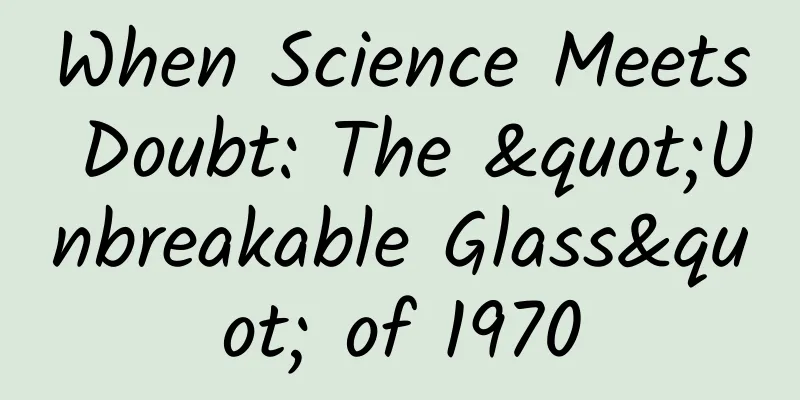When Science Meets Doubt: The "Unbreakable Glass" of 1970

|
Glass is one of the most fascinating materials in the process of human civilization. It is as thin as a cicada's wing, but it carries the dreams and wisdom of mankind across thousands of years. From the glass beads of the pharaohs in ancient Egypt, to the glass windows of the Roman Empire, to the optical fiber communication in modern technology, glass has witnessed every leap of human civilization. 1. The Origin of Glass: A Dialogue between Fragility and Toughness In 3500 BC, craftsmen in Mesopotamia first tried to melt glass. This transparent material, as clear as water, was not originally used for drinking utensils, but was regarded as decoration and jewelry. At that time, the ancient Egyptians regarded glass as a precious luxury, and the pharaohs regarded it as a symbol of wealth as important as gold. At that time, the brittleness of glass was always its biggest feature. An inadvertent collision could cause this seemingly hard material to shatter in an instant. This inherent fragility also became a difficult problem that engineers and scientists at that time constantly challenged. 2. The scientific secrets of glass: the magic of molecular structure The uniqueness of glass lies in its amorphous molecular structure. Unlike the structure of metals, the molecular arrangement of glass is disordered, and this disorder gives glass its unique physical properties. Scientists have found that by changing the composition and manufacturing process of glass, its strength and toughness can be significantly improved. During the East German period, Soviet scientists began an exciting experiment: to create a glass that was truly "unbreakable". Their goal was clear, but extremely challenging: to create a glass that could withstand the various accidents of daily use. 3. "Unbreakable Glass": Innovation in a Small Field In the 1970s, a scientific research team in East Germany began this seemingly impossible project. They used a special borosilicate glass formula and added trace amounts of metal oxides to the glass. After repeated experiments, they finally developed a glass cup that could withstand extreme impacts. The glass can survive a drop of two metres and can even withstand a blow from a heavy hammer. Scientists are ecstatic, thinking they have revolutionised a small area of daily life. 4. When science meets skepticism: a farce of the market Ironically, however, this seemingly perfect product could not be marketed. The Soviet Union hired Georg Schwarz, a sales legend in East Germany, to help promote this revolutionary glass. Schwartz was initially very excited about this product. As a professional with 30 years of sales experience, he immediately realized that this could be a groundbreaking product. He personally participated in many product demonstrations and even designed a series of impressive sales strategies. At a famous promotion meeting, Schwartz personally threw a cup from a height of two meters onto the hard marble floor - the cup was intact, causing an uproar at the scene! However, what is ironic is that even an experienced sales master like Schwartz failed to break through the deep-rooted psychological barriers of consumers. When he showed the incredible properties of the cup to potential customers, people did not exclaim in amazement, but showed doubts and mocking expressions. When salespeople demonstrated the product, people at the time often suspected that it was a trick. Even when scientists and Schwartz personally demonstrated the toughness of the cup by dropping it and using a sledgehammer, consumers remained skeptical. At that time, people were already accustomed to the brittleness of glass, and the concept of "unbreakable" glass was an impossible concept at the time. Schwartz later recalled: "We demonstrated miracles, but people only saw doubt." This case forced this experienced sales master to reflect that sometimes technological advances far exceed the imagination and acceptance of ordinary consumers. 5. Technological innovation and consumer psychology: the boundary between confidence and acceptance This case vividly demonstrates the complex relationship between technological innovation and consumer psychology. No matter how perfect a scientific and technological achievement is, it will be difficult to enter the market if it cannot win the confidence and acceptance of consumers. People are more willing to believe in their own experience and intuition rather than the seemingly incredible demonstrations of scientists. In today's era of information explosion, this story is particularly thought-provoking. We are often surrounded by various browsers, clickbait headlines, traffic appeals and fragmented information, which gradually weaken our ability to think and pursue the truth. The essence of science is to question, experiment and verify, rather than blindly accept or easily deny. Finally: The "Unbreakable Glass" Isn't the story of glass a microcosm of the progress of human civilization? From fragility to tenacity, from suspicion to belief, from ancient colored glaze to your mobile phone screen, every breakthrough comes from unremitting exploration and pursuit. Although the "unbreakable glass cup" in 1970 failed to be successfully commercialized, its significance seems to far exceed that of a simple and ordinary healthy glass container. This true history seems to remind us: Innovation is sometimes not just a technological breakthrough, but also a change in thinking. In a rapidly changing world, staying open, curious and rational is also a valuable asset for us. References 1. Varshneya, AK (1994). Fundamentals of Inorganic Glasses. Academic Press. 2. Zazky, J. (1991). Lenses and vitreous status. Cambridge University Press. |
>>: The magic weapon that strengthens plastics may be an "invisible assassin" of health!
Recommend
Short video operation guide for educational institutions!
For educational institutions, using short video o...
How to turn users who hate your product into the most loyal ones
During my short 5-year operation career, I spent ...
Operational case: The growth path behind "Zebra English" monthly revenue exceeding 100 million
What growth paths did Zebra English take to achie...
Millions of netizens watched the "strange fish" being caught, and many responded
Recently, Ruzhou City, Pingdingshan City, Henan P...
The elevator suddenly fell! How to start "self-rescue"?
Image source: Tuchong Creative If you often take ...
More than 100 million years have passed, and it is still a baby
Among amphibians, in addition to the "number...
The first domestic WiFi flight experience: average internet speed per person is 2M
Chatting with friends on WeChat, browsing the web,...
World Intellectual Property Day: Every innovative achievement deserves to be protected
When it comes to intellectual property, do you th...
How Product Managers Resolve Conflicts with Collaborating Departments
[[158761]] I was asked a question today: How do p...
Dewu App Android Cold Start Optimization - Application
Preface Cold start indicators are very important ...
The Internet Integration Model and Influence of American Television Media
When the Internet and other emerging media are su...
WeChat reading product operation analysis report!
In today's fast-paced life, people's time...
The homogeneity ceiling has already appeared. How can the mobile "show field" improve its competitiveness?
The competition in the PC-based "show" ...
Logitech x Baidu Brain VOICE M380 Voice Wireless Mouse Review: Free your hands and speak fluently
As the saying goes, the driving force behind tech...
Apple's secret to success: Don't be the first to strike back
[[137238]] Apple sold more than 61 million iPhone...









